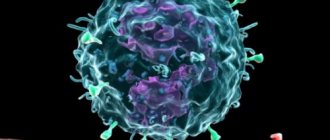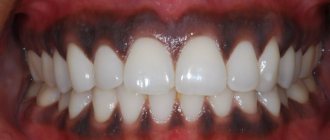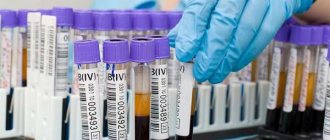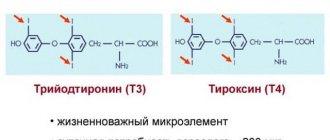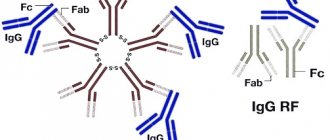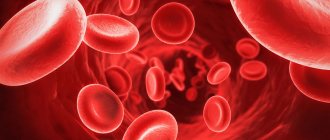Monocytes are low in the blood of an adult: what does this mean, how to increase it - About Blood
A monocyte is the largest blood cell, a mature white blood cell that does not have granules. They have the ability to absorb pathogenic cells completely in large quantities, as well as destroy microorganisms in environments with high acid levels.
The content of monocytes in the blood must be monitored, because deviations in any direction from the normative indicators may indicate the presence of certain disorders in the body. Let's consider what dangers low readings may indicate.
What monocyte parameters are low in adults? What is monocytopenia?
Granulated monocytes in the blood
The body of an adult healthy person contains from three to eleven percent of monocytes from the number of leukocytes in the blood (1 ml of blood contains 450 of their cells). The minimum permissible reading of their quantity is 0.04x109/l. The standard level of monocytes varies slightly: to a greater extent depending on age, to a lesser extent - on national characteristics.
If the proportion of monocytes in the blood is less than 0.04x109/l, that is, less than 1% of the number of all leukocytes, this indicates monocytopenia.
Monocytopenia is a decrease in the level of monocytes in the blood relative to their standard number, which is observed in septic processes. With monocytopenia, regulatory mechanisms in cells are disrupted and, as a result, this contributes to:
- favorable conditions for the development of infections in tissues and their rapid transport through the cells of the body;
- transformation of the flora of the intestinal mucosa and respiratory tract into potentially dangerous;
- inflammation of small suppurations;
- loss of information by the body about pathological agents.
Symptoms and signs of low monocytes in adults
Monocytopenia is only a symptom of a certain disease
A deficiency in the number of monocytes cannot be determined by external signs or certain manifestations of disorders in the body. However, frequent illnesses, reduced immunity and slow regeneration of skin lesions may signal that there is a reason to consult a doctor with these symptoms and donate blood from a finger prick for analysis.
Causes of monocytopenia
A decrease in the number of monocytes is associated with problems in their synthesis, for which the bone marrow is responsible.
A reduced level of monocytes (monocytopenia) is favored by the following factors:
- various types of anemia;
- leukemia;
- acute infectious diseases (they are characterized by a general decrease in the number of leukocytes);
- pyogenic infections;
- diseases of the circulatory system;
- long-term purulent processes in the body;
- long-term use of hormonal drugs;
- recent operations;
- shock states of the body;
- stress, emotional instability;
- chemotherapy;
- chemical poisoning;
- consumption of glucocorticoid drugs;
- the period after childbirth during the first week;
- physical exhaustion of the body after long-term diets or an unbalanced diet.
How to detect low monocyte levels
Laboratory tests can detect monocytopenia
To detect a low level of monocytes, it is necessary to take a general blood test from a finger prick. It can be prescribed upon request due to symptoms of monocyte deficiency, as well as for any abnormalities in the body.
You can decipher the test results yourself by comparing the indicators in the monocyte line on the coupon with the standard indicators, or by consulting a doctor.
The most accurate result will be given by the doctor when he finds out possible concomitant factors and characteristics of your body.
In some cases, the doctor may prescribe additional medical tests to more accurately determine the source of the disorder.
Treatment for low monocytes in adults
A low level of monocytes in the blood cannot be independently regulated: it will probably not be possible to raise their level, even if you yourself were able to suggest a possible cause for this condition.
If monocytopenia is detected, the doctor must establish a list of potential root causes and take measures to eliminate them, as well as normalize the body’s functioning.
Sometimes, especially if the reason lies in the exhaustion of the body after an unbalanced diet, it is enough to reconsider the diet to regulate the level of monocytes. In some cases, drug treatment is necessary if the cause of monocytopenia is acquired diseases.
If problems with the circulatory system, as well as cancer, are identified, it is necessary to understand that the process of normalizing the level of monocytes will take a long time.
In addition to taking into account the doctor’s recommendations, you need to remember the basics of a healthy lifestyle and adhere to a complete, balanced diet in order to quickly level your blood counts to normal values.
All changes to normalize indicators must be carried out under regular medical supervision and testing!
Threat with monocytopenia
Monocytopenia is a symptom that should not be ignored
Decreased monocyte counts may be a natural occurrence and not something to worry about, only in pregnant women. However, not always: even pregnant women need to constantly make sure that there are no deviations under the supervision of a doctor.
Maintaining monocyte counts within normal limits is essential. They are protectors that destroy foreign pathological agents, and also fight various infections, fungal diseases and help fight malignant cancer tumors.
In addition to the individual duties of monocytes, they, like other blood cells, perform the following functions:
- Destruction and prevention of the development of potentially dangerous pathogenic bacteria.
- Regulation of the body's immune responses to inflammatory processes.
- Control over protein production.
- Destruction of obsolete, damaged and defective cells from the body.
- Creating a favorable environment for tissue regeneration after external and internal damage.
The role played by monocytes is very important in the overall functioning of the body, so it responds negatively to any decrease in their number.
Prevention
A balanced diet is a good way to prevent monocytopenia.
To prevent monocytopenia, it is recommended to visit a doctor for blood tests at least annually.
You can help maintain an optimal monocyte count by simply improving your balanced diet.
Including buckwheat or oatmeal, onions and garlic, greens (especially celery), nuts, currants and blueberries, as well as apricots in your daily diet will help maintain blood in good condition. Homemade decoctions also perform this function: rose hips, wormwood leaves and honey.
It is strictly prohibited to take medications on your own in case of deficiency, but it is within your power to monitor a stable emotional state and provide the body with a complete nutritious diet.
Source:
Low monocytes in the blood: more than 10 reasons, what it means, how to increase it in a child, adult (women, men)
A general blood test (CBC) determines the main indicators. In a detailed study, the leukocyte formula is clarified - the percentage and number of white blood cells of various groups. Monocytes are a type of white blood cell.
These cells differ from others in their larger size and improved ability to phagocytose - absorb foreign material. A decrease in the level of monocytes in the blood is called monocyto- or monopenia.
This condition develops due to natural causes or indicates a progressive disease.
Functions and norms of cells
Monocytes are synthesized by the bone marrow from progenitor cells. The process usually takes 5 days. Almost all of them enter the bloodstream, a small part remains to perform a protective function.
In the general system, monocytes circulate from several hours to 4 days. They can concentrate in the liver, spleen, and lymph nodes. Moving throughout the body, cells mature.
In parallel, they carry out the main functions:
- involved in the production of blood clotting factors;
- participate in the “acquaintance” of T-lymphocytes with pathogens;
- needed for interferon production;
- play an indirect role in hematopoiesis;
- can activate systemic symptoms of inflammation (hyperthermia, for example);
- search for and absorb pathogenic microorganisms.
They differ from neutrophils ("fast reaction" cells) in that they remain active in an acidic environment, while neutrophils die. Monocytes are recognized as the “orderlies” of the body, since they neutralize the results of pathological processes - they destroy dead leukocytes, cells affected by viruses, bacteria or parasites, and break down dead own tissues.
Monocytes can absorb several large foreign agents or many small ones. They produce their own toxic substances that kill microbes (if the latter’s toxins are not stronger). Thus, the corpuscles can repeatedly perform their functions and suppress inflammatory reactions without the formation of pus.
It has been proven that monocytes play a major role in antiviral, antiparasitic and antitumor immunity. Whereas segmented neutrophils are more involved in reactions to fight bacteria.
Cells can penetrate through vascular walls and move chaotically towards pathological foci thanks to pseudopodia (outgrowths on the membrane). After maturation, monocytes form a marginal bed (accumulate in the parietal space of peripheral vessels).
Then they form a tissue bed - they pass through the walls into the surrounding space, where they become macrophages.
This type of immune bodies has an increased ability for phagocytosis and is involved in all types of protective reactions, the production of cytokines, and the absorption of not only pathogens, but also atypical cells of the body.
The normal levels of monocytes in the blood are equal for women and men. Not only the percentages and proportion among leukocytes are important, but also the absolute value (MON Abs.) - the number of cells per unit volume of blood (µl or l).
Table - Leukocyte formula norms
| Group of cells | Share, % | Absolute indicator, 10⁹/l |
| Band neutrophils | 1‒6 | 0,04‒0,3 |
| Segmented | 48‒75 | 2,0‒5,5 |
| Eosinophils | 0,5‒5 | 0,02‒0,3 |
| Basophils | 0‒1 | 0,0‒0,065 |
| Lymphocytes | 19‒37 | 1,2‒3,0 |
| Monocytes | 3‒11 | 0,09‒0,6 |
The indicators are common for people of different ages. Other reference values apply for children. Their number of monocytes may differ slightly due to natural imperfections in the functioning of the immune system in young children and the development of protective forces in infants.
Table - Monocyte norms for children
| Age, years | Norm, % |
| 0‒1 | 4‒10 |
| 1‒2 | 3‒10 |
| 2‒3 | 4‒12 |
If a CBC reveals an increased number of cells in the blood (more than 10%), they speak of monocytosis. When the proportion of cells in an adult is less than 2%, monopenia is stated.
It is important not only to evaluate monocyte parameters, but also to correlate them with other values in the analysis protocol. When the level is reduced against the background of a normal number of leukocytes (or an increase in the proportion of cells of another group), they speak of relative monocytopenia. If the content of all leukocytes is reduced, monopenia is considered absolute.
Causes of corpuscle deficiency
A decrease in the level of monocytes in the blood means the presence of a pathological process in the body, accompanied by a decrease in immune function. It is important to figure out at which stage the failure occurred. Monocytopenia may result from:
- insufficient production of cells by the bone marrow;
- redistribution of cells in the body;
- their increased consumption in tissues.
Source: https://igl-clinic.ru/analizy/monotsity-ponizheny-v-krovi-u-vzroslogo-chto-eto-znachit-kak-povysit.html
Causes of low monocytes
The normal content of monocytes in the blood relative to the total number of leukocytes is
- in adults – 3-11%;
- in children – 2-10%.
So, what can cause low monocytes?
A severe infectious disease initially causes a surge in the formation of phagocytes, but a long-term fight against the disease, the use of antibiotics and especially steroidal anti-inflammatory drugs lead to the fact that the generation of white blood cells decreases. Along with monocytes, the level of ordinary leukocytes decreases. The generation of monocytes is also suppressed
- long-term use of glucocorticosteroid drugs;
- chemical poisoning;
- ionizing or radiation radiation;
- severe stress.
All these factors lead to exhaustion of the body, which in turn leads to a decrease in monocytes. But if these factors are removed from the patient’s life, normal nutrition is provided, the biochemical and cellular composition of the blood will be restored. It is more difficult to cope with bone marrow diseases and blood pathologies.
Monocytes are low in adults. What does this mean? Monocytopenia
A monocyte is the largest blood cell, a mature white blood cell that does not have granules. They have the ability to absorb pathogenic cells completely in large quantities, as well as destroy microorganisms in environments with high acid levels.
The content of monocytes in the blood must be monitored, because deviations in any direction from the normative indicators may indicate the presence of certain disorders in the body. Let's consider what dangers low readings may indicate.
Monocytes are elevated, what does this mean?
What does an increase in monocytes indicate?
An increase in both the absolute value and the percentage of monocytes does not always indicate a serious pathology. A situation where monocytes in the blood are elevated in an adult or child occurs:
- After an infection, monocytosis is especially characteristic during the recovery period after chickenpox, scarlet fever and other childhood infections;
- For any allergic reaction, even a minor one (for example, skin rashes);
- After surgery for appendicitis, gynecological diseases.
Inflated monocyte counts in such cases are due to compensatory compensation of the phagocytic component of leukocytes: instead of dead lymphocytes and eosinophils, monocytes enter the blood en masse.
A more alarming condition is persistent monocytosis, when high levels are recorded upon repeated blood donation. Monocytes are elevated, serious reasons for concern:
- Severe infections - candidiasis (fungal infection of the genital organs, intestines, etc.), malaria, brucellosis, syphilis, tuberculosis and other specific bacterial diseases;
- Parasitic intestinal diseases - worms, if untreated, provoke changes when a child has increased monocytes in the blood; inflammation of the intestines - enteritis, colitis;
- Rheumatic pathology - arthritis, endocarditis;
- Systemic diseases - sarcoidosis, polyarthritis of rheumatoid etiology, lupus erythematosus;
- Blood diseases - thrombocytopenic purpura, leukemia, sepsis;
- Malignant tumors of various locations, including lymphogranulomatosis (Hodgkin's disease), increased monocytes may be the only sign in the initial stage of oncology development.
Monocytes are low in an adult: what does this mean? Causes of low levels of monocytes in the blood
Monocytopenia is a condition characterized by a decrease in the number of monocytes in the bloodstream. Monocytes are the largest blood cells and belong to the leukocyte fraction. A decrease in their concentration can be caused either directly by pathologies of hematopoiesis or by diseases of other organs and systems.
What does a reduced level of monocytes in the blood of an adult indicate? Let's talk about this in this article.
Functional significance of monocytes
The main function of monocytes is carried out after their release into tissues and transformation into macrophages.
However, even during the period when they circulate in the peripheral blood, which usually ranges from 8 hours to 4 days, these agranulocytes can partially realize their capabilities.
In tissues they also require time to degenerate under the influence of the microenvironment. During these periods they can perform the following functions:
1. Implementation of protection against virus-infected and tumor cells, bacteria and other microorganisms through phagocytosis (a link of nonspecific immunity).
2. Taking part in specific immune reactions directed against a specific pathogenic agent. Both as antigen-presenting cells and acting as effectors - participating in the direct elimination of foreign material.
3. The secretory activity of monocytes is necessary to regulate the proliferation and activity of surrounding cells, as well as to influence the state of the intercellular substance. They also secrete special microbicidal substances into the spaces between cells.
4. Participation in the processes of apoptosis - the programmed death of structural units of the body. Monocytes absorb fragments of cellular structures - apoptotic bodies formed as a result of cleavage by enzymes inside the cell itself; as a result, it breaks down into these same elements, which are digested by phagocytes.
5. Monocyte agranulocytes, under the influence of exogenous influences, can produce endogenous (internal) pyrogens - substances that stimulate an increase in body temperature by affecting the thermoregulation center in the brain.
Agranulocytes of the monocytic series play an important role in the implementation of immune surveillance, so a decrease in their number cannot but affect the protective functions of the body.
Normally, in adults, their concentration should be at the level of 240-700 cells/μl (cells per microliter). When calculating the leukocyte formula, which reflects the content of certain types of white blood cells per 100 leukocytes, the share of these phagocytes should account for 3-11%.
Monocytopenia develops when the number becomes less than 3 monocytes per 100 cells.
Reduced monocytes in an adult: reasons
Speaking about factors that can cause such changes in a general blood test, we should separately mention a group of diseases associated with pathologies of the bone marrow and the blood system as a whole.
They lead to a decrease in the production of monocytes or their defective functioning. These conditions include the following:
1. B12-folate deficiency anemia - develops as a result of a lack of vitamins such as cyanocobalamin and folic acid. This, in turn, disrupts the processes of proliferation (reproduction) of cells; bone marrow cells are the most sensitive to this due to their constant proliferative activity.
2. Aplastic and hypoplastic anemia.
In this case, due to various damaging factors affecting the bone marrow, its function is depleted and the reserves of hematopoietic precursors are deficient or completely absent in the aplastic form.
It should be noted that at the initial stages of the disease, the concentration of monocytes may remain within normal limits and even increase relative to the more sensitive series of granulocytes - a decrease in the production of which is observed first.
3. Acute lymphoblastic or myeloblastic leukemia - with this pathology, a relative decrease in the concentration of monocytes is observed, due to a sharp increase in the content of other leukocyte fractions.
4. The presence of metastases in the bone marrow leads to a kind of “displacement” of normal cells, and the function of the organ suffers.
5. Congenital and acquired immunodeficiencies may also be accompanied by monocytopenia.
6. Impact on the bone marrow of various toxic substances and radiation. This should include chemotherapy, arsenic poisoning, and heavy metal compounds.
It is important to remember that a low monocyte count in most of these conditions is only a sign - it is not considered a diagnostic criterion and may not be observed in all cases. In addition to the above pathologies, other reasons can lead to a decrease in the level of these agranulocytes:
- infectious diseases with intense inflammatory processes;
- the presence of a systemic inflammatory reaction – sepsis;
- uncontrolled use of glucocorticosteroids;
- condition after surgery, trauma, burns, heavy bleeding;
- the presence of an oncological process of any localization.
In addition to the above medical reasons, some physiological conditions such as pregnancy and lactation in women can also lead to the development of monocytopenia. Also, non-pathological reasons for a decrease in the level of agranulocytes include chronic stress, systematic lack of sleep and prolonged fasting.
Decrease in monocytes: symptoms and treatment
The clinical picture accompanying a decrease in the concentration of monocytes, first of all, depends on the specific cause that caused this condition.
Considering that monocytes are responsible for fighting bacterial infections, if the normal activity of lymphocytes, the body’s main defenders against viruses, is maintained, there will be a decrease in resistance to various types of bacteria. This can lead to the following clinical picture:
- presence of headache, decreased ability to work;
- various inflammatory diseases of the mucous membranes: gums, mouth, middle ear.
- the presence of low-grade fever, usually at the level of subfebrile values;
- development of respiratory complications, including pneumonia.
In some cases, the addition of fungal infections is observed. However, for the most part, an integrated approach is needed to strengthen the body’s protective functions and combat specific diseases of organs and systems:
- strict adherence to the doctor’s prescriptions and recommendations regarding the treatment of the underlying disease;
- adherence to a healthy diet with a high content of vitamins and microelements, products that help strengthen the body’s protective functions: honey, ginger, citrus fruits, rose hips and fermented milk products.
- eliminating any stress factors and maintaining a gentle work regime.
Among traditional medicine recipes, there are many ways to strengthen the immune system. For this purpose, plants such as ginseng, echinacea, aloe and walnut leaves are used. However, before using them as immunostimulants, you should consult your doctor.
Source: https://mag.103.ua/analizy/6383-monocity-ponizheny-u-vzroslogo/
Reasons for increased monocyte levels in women
Today, there are quite a large number of pathologies that can provoke a sharp increase in the number of cells of this type. Infections and viruses can not only reduce, but also increase the number of monocytes. Moreover, in many cases with a chronic form of infection, the number of these cells does not fall even during remission of the underlying disease, since immunity is not fully restored.
Sepsis is also a common cause of monocyte growth. Usually this phenomenon can be prevented by following the rules for treating wounds and cuts.
This is why it is so important to monitor the patient’s condition in case of extensive lesions and in the postoperative period. It is allowed to receive treatment with anti-inflammatory drugs for prevention in the first 1-5 days after the intervention
At the same time, be sure to change the bandages, if any, so that dead parts of cells do not accumulate under them.
Causes of increased monocytes
Malignant and benign tumors can provoke the growth of blood cells of this type
It is important to carry out an MRI or CT scan if possible if examination without these manipulations does not help to find out the cause of the pathology. In the images, the doctor will be able to find the source of inflammation or neoplasm and prescribe adequate therapy
It can take place in a day or permanent hospital setting.
Diseases of the gastrointestinal tract due to inflammation and damage to the mucosa provoke the release of a large number of toxic substances into the blood, which can change its formula. Typically, such an illness is accompanied by aching or sharp pain, nausea, discomfort in the abdomen and problems with stool. At the same time, women are more susceptible to gastrointestinal problems than men.
Monocyte structure
In addition, the following diagnoses may cause the pathology:
| Cause | Frequency of occurrence |
| Leukemia | Rarely |
| Fungal diseases | Often |
| Viral diseases | Often |
| Collagenosis | Rarely |
| Kidney and urinary tract diseases | Sometimes |
| Phosphorus poisoning | Rarely |
| Surgery on the pelvic organs | Sometimes |
Functions of monocytes
For early detection of any pathologies in the female body, it is important not only to listen to your feelings, but also to undergo annual examinations on time. It is enough to take blood tests 1-3 times a year
This will allow the specialist to predict the possible development of events and, if necessary, carry out quick and competent treatment.
Reasons for the increase and decrease in monocytes in the blood of an adult
This is what a monocyte cell looks like (in the center) under a microscope
Monocyte cells are nothing more than large white blood cells. First of all, you need to understand what cells of this type are responsible for. Their main functions are to provide protection to the human body from foreign cells by clearing the blood of physical agents. Monocytes have the ability to absorb not only parts of foreign microorganisms, but also their entirety.
These cells are also found in lymph nodes and tissues, not only in the blood.
Important! Monocytes cleanse the body. The main function of these cells is to create certain conditions under which regeneration processes are launched in tissues. This function is activated if the tissues have been damaged by foreign organisms, due to inflammatory processes and lesions, or due to the development of tumors.
What should their level be?
We looked at what monocytes are in a blood test, now it’s time to figure out what their indicator is normal. Since these cells are one of the types of leukocytes, their measurement involves determining the percentage of monocytes in the number of leukocytes.
Important! This indicator is absolutely independent of gender or age differences, and therefore the norm of monocytes in women and men is at the same level. There are only slight differences by age and during certain periods of pregnancy.
A short video about the purpose and properties of monocytes
The normal content of these cells is as follows:
- At the age of 10 years it ranges from 2 to 12%.
- Upon reaching 12 years of age - 3-10%.
Absolute monocyte content - what is it?
Table of the content of all forms of leukocytes in the blood
In the case of measuring monocytes, their absolute content in the blood, and not just the percentage, plays a very important role. The fact is that a general blood test determines their quantity only relatively. Therefore, a special technique was developed to determine the absolute content of monocytes in the cells of one liter of blood.
This indicator is recorded as “monocytes abs.” or Mon#. "Abs." in this case it means “absolute”.
The absolute norm for monocytes in adults is 0-0.08×109/l. In children under 12 years of age, this indicator ranges from 0.05 to 1.1 × 109/l.
What does the increased level indicate?
If monocytes are elevated, the disease is called monocytosis. When there are elevated monocytes in the blood, this indicates the presence of foreign agents in the blood, which may indicate the development of neoplasms and infections.
Let's take a closer look at what this means - increased monocytes in the blood. This phenomenon can develop against the background of a number of diseases, so such signs should never be ignored:
- This may indicate the development of tuberculosis.
Very often, an increase in monocytes indicates the development of tuberculosis
- Possible lymphoma or leukemia.
- An increased level of monocytes in an adult may indicate the presence of infectious diseases in an acute form during the recovery stage. This could be measles, rubella, mononucleosis, diphtheria, etc.
- Lupus erythematosus, rheumatism, etc.
Important! Abnormal levels of monocytes in the blood are observed in mononucleosis. This infectious blood disease very often affects children.
What does the decreased
If monocytes are low, the disease monocytopenia is diagnosed, against which anemia can develop and the level of other blood elements sharply decreases.
Folate deficiency anemia and aplastic anemia are the two most common causes of low monocyte levels. Monocytopenia is also one of the most common symptoms of treatment with glucocorticoid-type drugs.
Normal (left) and decreased levels of monocytes in the blood
Important! If segmented monocytes are completely absent from the blood, then this is a very bad sign. Most often we are talking about a severe form of leukemia, in which the production of monocytes stops. Sepsis may also be the cause, when there are not enough monocytes to cleanse the blood and blood cells are destroyed as a result of exposure to toxins.
Thus, serious health problems can occur with both increased and decreased levels of monocytes in the body. Therefore, if you suspect any problems in this area, you should immediately consult a doctor.
We recommend studying similar materials:
- 1. Hemostasis system: why take a blood clotting test
- 2. How to choose a diet based on your blood type: losing weight together
- 3. Causes and dangers of increased basophil levels in children
- 4. The level of basophils in adults has decreased: how to treat basophilia
- 5. Reasons for an increase or decrease in neutrophils in a blood test in children?
- 6. Functions and possible causes of pathologies of segmented neutrophils
- 7. Norms for the content of neutrophils in the blood and what functions they perform
Source: https://MoyaKrov.ru/normy-i-patologii/norma-monotsitov-v-krovi/
What is the role of cells?
Monocytes perform, first of all, the function of absorbing dead cells and resisting parasites, viruses, and microbes. They protect the blood from the harmful effects of pathogenic microflora and take part in tissue renewal. Therefore, these cells are often called “the body’s wipers.”
Monocytes play an important role in the life of the body, performing the following functions:
- Protects against infections.
- Helps damaged tissues recover faster.
- Prevents the development of tumors.
- Absorb dead cells.
- Destroy parasites that penetrate the human body.
These cells live only two to three days. After this, they enter the tissue, where they are converted into tissue macrophages. They have the property of suppressing the development of tumors and are responsible for the production of interferon.
The level of monocytes in the blood does not change depending on gender, but there is a slight difference by age. Normally, the content of these cells in an adult should be from 3 to 11% relative to the total number of leukocytes. In children, the rate varies between 2-12%.
Monocytes
Monocytes: main functions, reasons for decrease and increase, treatment
A general blood test indicates the level of monocytes. Sometimes it can be increased or decreased. Many patients wonder what this indicator means and how dangerous its fluctuation is.
Monocytes are large mononuclear leukocytes belonging to the group of agranulocytes. These are oval-shaped cells with a large nucleus, which is rich in chromatin. Their cytoplasm does not contain grains.
These cells are formed in the bone marrow from monoblasts. After leaving it, they are transported through the blood within 36-104 hours, then absorbed into the tissues.
Here they are transformed into histiocytes - tissue macrophages.
Their main task is to destroy foreign elements when interacting with an acidic environment and remove dead cells, bacteria, denatured protein, etc. from the body. They are involved in hematopoiesis, lipid and iron metabolism, and hemostasis.
Large white cells are highly active, especially when circulating through the bloodstream. They are found in the liver, bone marrow, lymph nodes and spleen.
For their effectiveness in eliminating foreign bodies from the body, monocytes are called “janitors”.
Functions:
- protecting the body from microbial infection;
- tissue regeneration;
- antitumor protection;
- phagocytosis of damaged and dead tissue cells;
- toxic effects on parasites entering the human body.
The capture of foreign particles in the body by macrophages consists of 2 phases: attachment of the foreign body to the white cell and its absorption. In the first phase, protoplasm is excited, and the need for oxygen increases. White cells that have entered this phase are called activated.
Their rate of absorption of foreign bodies increases.
The second phase is longer. It is called protoplasmic adaptation. It is characterized by an increase in the content of certain macrophage enzymes and an increase in energy requirements. At this stage, the metabolism of lipids increases to replace those consumed.
Bacteria captured by monocytes are not always destroyed. Their fate depends on the metabolic state of the cell, the presence of opsonins, etc. For example, virulent bacteria not only remain alive, but are also able to reproduce in the cytoplasm of monocytes.
You can find out the normal levels of triglycerides in the blood here, in detail by age and gender.
Monocytes are measured as a percentage of leukocytes in the blood, as they are a type of leukocyte. Their amount in the blood of children depends only on age; gender does not matter (Table 1).
Table 1. Norm of monocytes in children by age
AgeNumber of monocytes, %
| newborn | from 3 to 12 |
| up to 2 weeks | from 5 to 15 |
| from 2 weeks to 1 year | from 4 to 10 |
| from 1 year to 2 years | from 3 to 10 |
| from 2 to 5 years | from 3 to 9 |
| from 6 to 16 years | from 3 to 9 |
| after 16 years | from 3 to 9 |
The number of monocytes in children changes with age.
In adults
The norm for an adult is from 1 to 8%. The indicator increases with age. Gender does not affect the level of monocytes in the blood. Exceeding the specified maximum limit is a serious signal. A person has monocytosis.
The disease is divided into absolute and relative. In the second case, an increase in monocytes is accompanied by a decrease in leukocytes. With absolute monocytosis, only the content of monocytes increases.
Causes of low monocyte count
With a reduced content of monocytes, monocytopenia develops. Its causes are different in adults and children.
The causes of monocytopenia in children are:
- anemia;
- severe exhaustion of the body;
- infectious diseases;
- insufficiency of bone marrow functions;
- consequences of chemotherapy radiation.
If monocytes are low in an adult, then their causes may be:
- infectious diseases;
- shock;
- bone marrow damage;
- surgical intervention;
- purulent diseases;
- strong radiation;
- exhaustion of the body;
- chemical poisoning;
- long-term treatment with hormones.
A decrease in monocytes is possible in women after childbirth or during pregnancy. During these periods, it is necessary to regularly check their blood levels.
Reasons for the increased content
Monocytosis in children can be caused by:
- infectious disease - this is the most common cause;
- rheumatism or lupus erythematosus;
- surgical intervention;
- development of diseases: malaria, toxoplasmosis, syphilis, mononucleosis, etc.
Sometimes the cell content in a child’s blood increases after suffering a serious illness. It can occur during teething. Sometimes the cause is hereditary abnormalities. In any case, additional examination is necessary to identify the exact cause and eliminate the disease.
The disease develops in adults when:
- tuberculosis;
- acute infectious diseases;
- connective tissue diseases: rheumatism, lupus;
- malaria and leishmaniasis;
- poisoning with phosphorus and other substances;
- surgical intervention;
- fungal diseases;
- cancerous tumors.
The list of causes of monocytosis is not exhaustive. It may appear in the early stages of recovery and be temporary.
Both a decrease and an increase in monocytes can lead to negative consequences for a person. They can be harbingers of serious diseases that cannot be eliminated without medical intervention.
Monocytopenia
If a general blood test shows a low monocyte count, you should immediately consult a doctor to prevent the progression of the disease.
Treatment of monocytopenia is the elimination of the causes that caused the disease. In each case, the list of measures to cancel them is different. Sometimes it is enough to revise your diet to increase the number of cells to the desired level. In some cases, special medications and surgery will be required.
What are monocytes and their function
Monocytes are blood cells that belong to leukocytes. Compared to all elements of the leukocyte mass, these cells are the largest in size. The production of cells is carried out by the bone marrow; it is this that supplies useful, immature monocytes into the blood mass, increasing the patient’s immunity.
At this stage, they absorb harmful enzymes, viruses, bacteria and quickly digest them, preventing them from developing into a full-fledged disease. In addition to directly destroying harmful organisms, monocytes are able to accelerate the regeneration of cells in affected tissues and relieve inflammation. After digestion of bacteria and viruses, the dead enzymes are excreted through the kidneys. That is why problems with their functioning can cause an increase or decrease in the total number of cells.
What are monocytes
What to do if monocytes are not normal
Please note that if, when reading a blood test, you see a problem with monocytes, you should not look for the answer to the question of how to lower monocytes. Why lower their level if they are fighting infection? First of all, you need to contact a specialist who will conduct an examination, carefully collect an anamnesis of the disease and compare test data.
If necessary, additional clarifying studies can be carried out
First of all, you need to contact a specialist who will conduct an examination, carefully collect an anamnesis of the disease and compare test data. If necessary, additional clarifying studies can be carried out.
Attention! Treatment is prescribed only after a diagnosis has been established, that is, the cause of the deviation in the tests has been identified.
Main reasons for the decline
So, we have already understood that monocytosis (when there are too many phagocytes) generally indicates the presence of an inflammatory process in the body. Often, for example, this is characteristic of infectious mononucleosis, as well as diseases that have a long and sluggish course (for example, tuberculosis). But what does the situation mean when a child’s monocytes, on the contrary, are low? In fact, there may be several reasons and, I must say, many of them are quite serious. The first is sepsis. This terrible word refers to a situation when a large number of pathogenic microbes are present in a person’s blood, which are spread to all organs and tissues (relatively speaking, phagocytes cannot cope with the task assigned to them, enemy agents win at this stage, and defenders die in an unequal battle) .
Did you know? Translated from Greek, “sepsis” means rotting. This pathology, as a rule, is caused by certain bacteria (and often they act “together”, that is, there are several pathogens), less often - viruses, fungi and other parasites. In fact, a person becomes infected with sepsis “from himself,” from his own microflora, for example, as a result of unsuccessful treatment (surgical or antibacterial) with a weakened immune system. The second is leukemia. This condition is characterized by relative monocytopenia, that is, there are few of these particles not in general, but relative to the total number of leukocytes. The pathology is that the bone marrow produces too many cells, they do not have time to divide into the necessary types in the correct proportions, and, accordingly, cannot properly cope with the task assigned to them. Entering the bloodstream in such an “immature” state, such particles can do more harm than good (leukemia is also called leukemia or blood cancer). It is interesting that there is a concept of chronic monocytic leukemia - a disease characterized by the presence of a tumor growing and damaging surrounding tissues, located in the blood system and consisting precisely of monocytes transforming into atypical cells. To reassure parents, let's say that such an oncological disease very rarely occurs in children and, by the way, is characterized, rather, by an increased number of monocytes in the blood. This is such a paradox. Important! Blood cancer cannot be diagnosed by a general blood test, since the number of monocytes in this pathology is not always low. But if this indicator is still present with established leukemia, it indicates that the child’s condition is critical, and treatment (if it was carried out) does not give the proper effect. That is why the level of monocytes in the blood helps not only to establish leukemia, but to determine the success of therapy. The results of a general blood test in question may also indicate a violation of the hematopoietic function of the bone marrow (so-called aplastic anemia). In this case, the levels of other particles in the blood are usually reduced. In turn, such a pathology is most often a consequence of a viral infection, trauma, surgical treatment, medication (in particular, after taking steroid hormones) or other intoxication of the body, hormonal imbalance, and even severe stress or shock.
Sometimes such anemia occurs for such a trivial reason as a deficiency of folic acid (vitamin B9). But in certain cases, aplastic anemia can also be congenital.
Another dangerous pathology of the immune system, which makes itself felt by a reduced number of phagocytes in the blood, is the so-called systemic lupus erythematosus. This disease is accompanied by damage to the skin, liver, joints, cardiovascular system and even the psyche. One of the most obvious symptoms of systemic lupus erythematosus is a characteristic butterfly-shaped rash on the face (cheeks + bridge of the nose). This is where the name of the disease came from: our distant ancestors associated the location of the rash on the face with wolf bites. Thus, this reason for a “bad blood test” can be discarded if there is no very definite and noticeable sign of it.
Did you know? Human blood is red in color due to the iron it contains, which acts as an oxygen carrier. Some species of spiders have blue blood because copper serves as an oxygen carrier. A decrease in the level of phagocytes in the blood can also be caused by other infectious (especially purulent) and inflammatory diseases, when the immune system does not fully cope with its protective function and loses ground in the face of the enemy. But sometimes even banal worms or just a general loss of strength can cause such an indicator (although in this case you should not ignore the signal, because it indicates that the body’s resistance is below normal). It is also important to understand that downgrading is not the same as downgrading. Sometimes an analysis shows that the number of monocytes is zero, in which case the child definitely needs to be saved urgently, but a slight deviation from the norm below the established limit is, rather, a reason to think seriously than to fall into a stupor and say goodbye to life.
By the way, relative monocytosis, when there are many monocytes and few lymphocytes, is also not a very good symptom. In general, this is a topic for a separate conversation; here we just want to once again focus on the fact that it is important to distinguish between relative and absolute deviations from the norm in the indicator of a given type of phagocyte in the blood and certainly not to self-medicate.

